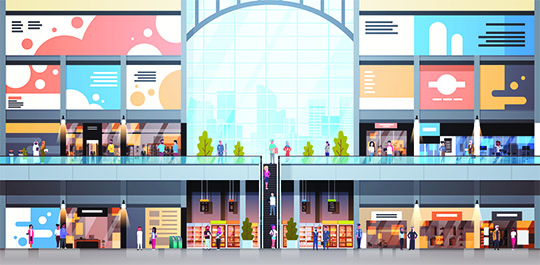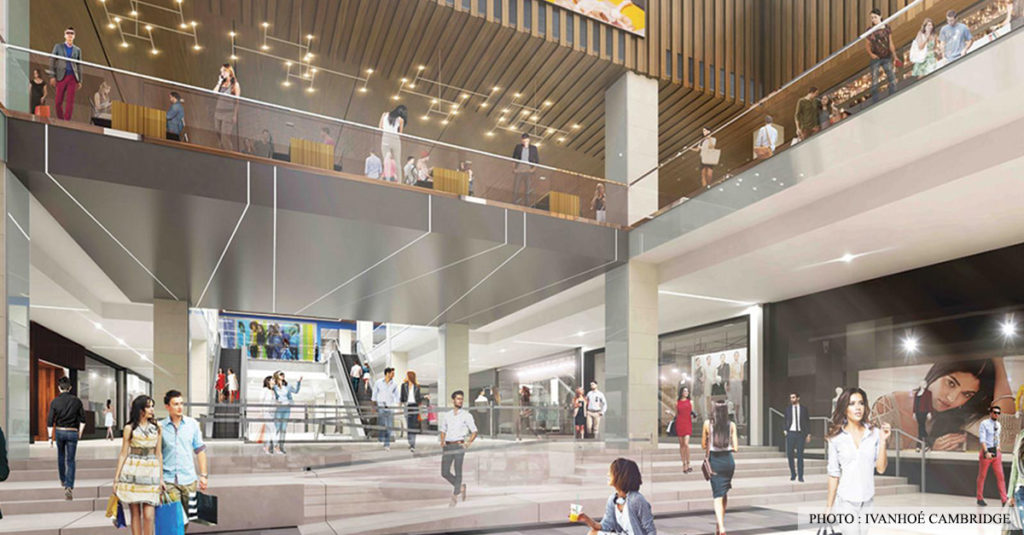Return of the mall
January 15, 2020For years, the North American shopping mall was said to be dead on its feet. Now, a new generation of developers and retailers are bringing them back to life as vibrant community spaces.

“ONE of the first jokes I ever heard back in planning school,” chuckles Brent Toderian, “was that if you want to know what’s happening in Canada, take a look at the United States 10 years ago.”
Although Toderian, Founding President of the Centre for Canadian Urbanism (and former Chief Planner for both the city of Vancouver and the province of British Columbia), is referring to his own profession, the same could be (and has been) said about the world of retail, in terms of everything from shopping habits, to eCommerce, to the adoption of IoT ad RFID technology. However, as Toderian points out, there is one area where Canada is leading the charge: spearheading the transformation of shopping centres—long considered to be in decline—into vibrant, community live/work spaces, to the benefit of retailers, landlords, and for the entire community.
“Unlike in the U.S., in Canada, we didn’t wait for our malls to fail before we recognized their opportunities,” Toderian explains. “They’re the low-hanging fruit for suburban transformation if we understand that it’s critically important to transform the suburbs into places that are more multi-mobile and more urban. And you have these malls— they’re large land holdings, they’re under single ownership, and they have a bunch of wasted land because they overbuilt parking. They’re also usually in areas conducive to rapid transit and LRT.”
Turning Inside Out
Fortunately, Canadian shopping centres already had a head-start. In the United States, Toderian notes, the power of the urban planner is considerably more limited, and as a result, American shopping malls sprung up at rates four- or five-times higher than they did north of the border.
“The United States was the Wild West of retailing,” he grimaces. “You’d have these ludicrous scenarios where brand-new malls popped up right across the street from a mall built the year before—and neither of which had the market support necessary for them to survive.”
But following the global financial crisis of 2008, and the steady encroachment of eCommerce, American malls began to shut down at alarming rates. In 2017, Credit Suisse predicted that inside of 5 years, up to a quarter of America’s malls could close. By contrast, Canada’s top malls are stronger than ever; according to Retail Council of Canada’s Canadian Shopping Centre 2019, while US shopping centres have seen declining sales per square foot since at least 2014, Canadian malls have recorded substantial gains (in the case of Toronto’s Yorkdale Mall and Vancouver’s Pacific Centre, those gains have been as much as 10-15%). Retail space left vacant by large brands like Sears are now being filled by more than 50 international brands entering the country. But it’s more than that, Toderian explains; the very concept of the suburban shopping mall is in the midst of an evolution, with the addition of rapid transit, mixed-use space (including condo towers), and various community amenities.
“Can they become more community spaces?” he muses. “Can they involve things like library branches or community centres? Can they be turned inside out, to become more like a Main Street? Can their hallways be outdoor and be more street-like? And beyond that, some places have even started sprouting towers. They’ve started to be reconsidered as fundamentally different, denser urban places that also involve housing. And not just on top of all that parking, but as part of the mall itself. The final evolution is for it not to even be a mall anymore—not just a different kind of mall, but a totally new kind of urban place. A piece of city in the suburbs.”
One site in the middle of such an evolution is Edmonton’s Bonnie Doon Shopping Centre. Built back in 1958, the mall took a series of hits in the early-and-mid 2010s, with major retailers like Sears, Target, and Zellers all closing up shop. However, as Margaret Knowles, Senior VP of Development with Morguard (who own the Bonnie Doon development) explains, these temporary setbacks actually provided an opportunity to reimagine the site as a bustling live/work district—one that will one day include rapid transit, business, public parks, and up to 4,000 units of residential housing.
“It started in the 1950s as a great community mall, but then it tried to be bigger than that,” Knowles says. “One developer after another expanded it, and then it got a bit too big […] And then in the early 2000s, Target went down, and within a few years, Sears went down, and it wasn’t obvious to anybody what to do with either of those boxes.”
Taking into account Bonnie Doon’s location—close to Edmonton’s French Quarter, and near all manner of public amenities—Morguard went into community consultation with a multi-decade plan to fully redevelop the site, incorporating not just those existing amenities, but the region’s geography—physical and social.
“We’ve got the valley, and the river nearby,” Knowles adds. “There’s a lot of natural geography. People are hiking through there. And then, where our transit is going in, there’s been a major investment by the city in things like community centres and state-of-the-art sports facilities. To the north of us, we have a library and a health clinic. We have so many great amenities around us, we’re in a great area. I can tell you after coming through two years’ worth of rezoning and community consultation, it’s so beloved by the community itself. That can be a constraint on one hand, because you have to work within that, but because it’s so beloved, you’re starting with this tremendous amenity in your back pocket, and our job is just to make everything that’s great about it even more dynamic.”
And, Knowles says, Bonnie Doon has also recently invested even further in community building through a partnership with Makami College, a homegrown educational institution that aims to bring business savvy to a new generation of entrepreneurs.
“[Makami] are the kind of entrepreneurs of the kind you seem to only find in Alberta. They’re a family business that just keeps growing, in teaching skill sets in high-growth areas like therapeutic massage and things like that. They’re in the business of getting both new Canadians and existing Canadians into business life and helping them earn good incomes.”
And even though the completion of the project is decades away, Knowles has confidence the project will succeed, in part because it’s able to build on an existing and vibrant community.
“One thing about Bonnie Doon that’s unique is that, although ultimately it will be a complete teardown and rebuild, we have the ability within the plan to keep the really good parts of the retail environment alive,” she says, “and in fact, even strengthened by the fact that we’ll soon have transit at our doorstep.”

Sprouting Towers
As Toderian points out, the transformation of Canadian shopping malls is somewhat unique— not just in North America, but worldwide. And within Canada itself, the epicentre of retail redevelopment is Metro Vancouver. Of the ten top-performing shopping centres in Canada, four are in the Metro Vancouver area, and after Yorkdale Mall, Cadillac Fairview’s Pacific Centre is the second most profitable shopping centre (outpacing Yorkdale by five million annual visitors).
“Metro Vancouver in particular is the hotbed for this in all of North America,” says Toderian. “There are more transforming malls in Metro Vancouver than probably anywhere else in the world. You can’t swing a stick without hitting a mall that’s either turning itself inside out, sprouting towers, or both.”
In large part, Toderian notes, this has to do with the city’s sky-high property values, but also because of a growing awareness of traditional mall owners of the potential to turn their underutilized areas into property goldmines.
“When we first started talking about this, most mall owners weren’t interested,” he recalls. “But now, with land values what they are, it’s such a no-brainer, even if it wasn’t their thing, it’s become increasingly dumb not to at least consider it. So today, some mall-owners are rethinking their business model. Some malls are being bought by developers who do both. But in other cases, the easiest thing might be a joint venture.”
Toderian goes on to cite examples of innovative partnerships—some between commercial developers and residential ones—but notes that ultimately, the reimagining of today’s shopping centres will be a partnership between developers and cities, a community-building exercise that will, in the likely event it succeeds, put Canada’s malls a decade ahead of their American counterparts—and not the other way around.
“It’s not just a game-changer for retailers,” he concludes. “It’s a game-changer for the entire suburban experience. It’s a game-changer for mobility, because you’re putting density on top of transit. It’s a more efficient usage of land. There are so many public interest reasons to want to do it, beyond just developer profits—although there’s that, too.”
BY JESSE DONALDSON



